Wr450f 2015
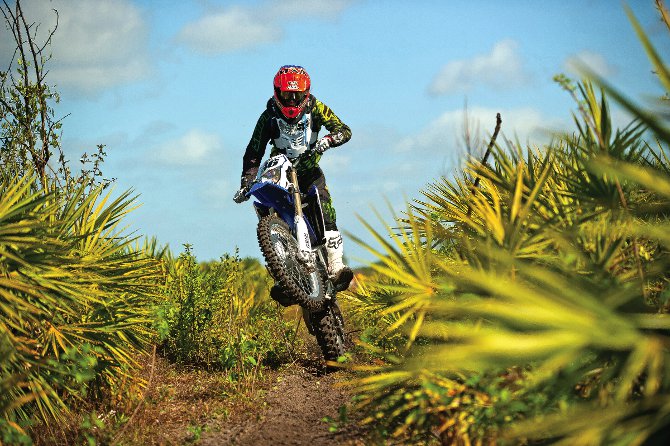
By John Basher
With age comes wisdom, and clarity is not far behind. Not to sound dour, but the race of life will be over for all of us sooner rather than later?which is why, at the ripe old age of 30, I wanted to expand my horizons in exciting but prudent ways. For some people, that means getting a tattoo. I don't like needles. For others, it is skydiving. I'm not Travis Pastrana. Perhaps I could take up a career as a hot-dog-eating contestant. No, Joey Chestnut I am not.
As you can see, there are many experiences that have passed me by, or that I was simply too narrow-minded to be a part of. This avoidance-avoidance strategy has worked out well for me in most cases. For example, I've never spent time in a hot tub with Rosie O'Donnell. I've never taken a Caribbean cruise on one of those floating Roman palaces where everybody ends up sick, mysteriously overboard or grounded on a shallow reef. I've never gone scuba diving to feed sharks?which, to my mind, is like a piece of filet mignon holding a dog biscuit out to a hungry wolf.
My conservative strategy has ensured that I've avoided unpleasant experiences, but it also means that I've missed some amazing adventures. Perhaps?just perhaps?I should push my comfort zone. For the sake of personal development, I decided to do something unique, different and wildly exciting. What? I decided to leave my safe little niche as a motocross racer and venture into the world of long-distance, cross-country racing.
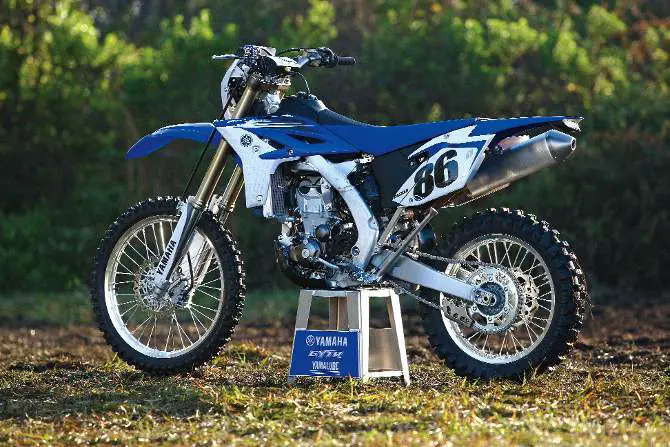
Does this bike look familiar??It should or at least parts of it should. Don't be confused by the kickstand and headlight. The WR450F uses a 2012 YZ250F frame.
CHAPTER ONE: THE BUILDUP TO ADVENTURE
I decided to race a round of the Grand National Cross Country Championship (GNCC). It may not sound all that daring, but in my cozy little world of motocross, it is a big deal to be berated by my buddies as an "enduro guy." Regardless of their derogatory comments, I punched an airline ticket and instead of avoidance-avoidance, I was going to take a risk and switch to approach-avoidance, which meant that I would skip the weekly moto wars and instead race a grueling two-hour GNCC race (something that wasn't in my wheelhouse… thus, avoidance).
As a rule, the MXA wrecking crew likes to go out and do different things, things outside of the motocross realm. I did a tandem backflip into Travis Pastrana's foam pit once?but I think once is enough when it comes to being upside down on a motorcycle. MXA has raced Supermoto, Endurocross, flat track, road race and traveled to the Philippines, Finland, Sweden, Japan and, in this issue, the Middle East, to race. Although, in almost every case, I didn't do it. We make MXA's test editor Dennis Stapleton get completely out of his element for the sake of a unique story (and, admittedly, we love to watch him squirm).

The WR450F follows Yamaha's centralization of mass theory. The engine has been rotated back to improve the handling.
But, this time, I wanted to be the crash-test dummy. I wanted to push myself. I wanted to see how the other half lives. So, instead of Dennis Stapleton, whom we had sent off to do a story in some other far-off corner of the globe, this time I'd be out on the unfamiliar limb.
It's also worth noting that MXA tests offroad bikes as frequently as politicians tell the truth. But every so often a politician is honest, and, truth be told, this is the second offroad bike that MXA has tested in 2012. The first was a KTM 300XC two-stroke that we turned into a motocross bike. The 2012 Yamaha WR450F is the second.
My chief objective in going to a GNCC race and test the all-new Yamaha WR450F. The Yamaha brass had spent the better part of three years developing an all-new version of their popular WR450F, and the River Ranch GNCC race was going to be their coming-out party. Even though it wasn't a motocross bike, I begged Yamaha to give me a WR450F for the race. Either they were excited to have me along, or they wanted to see me wilt in the Florida sunshine. But whichever it was, Yamaha made an exception and let a motocross magazine editor come to their offroad new-bike introduction.
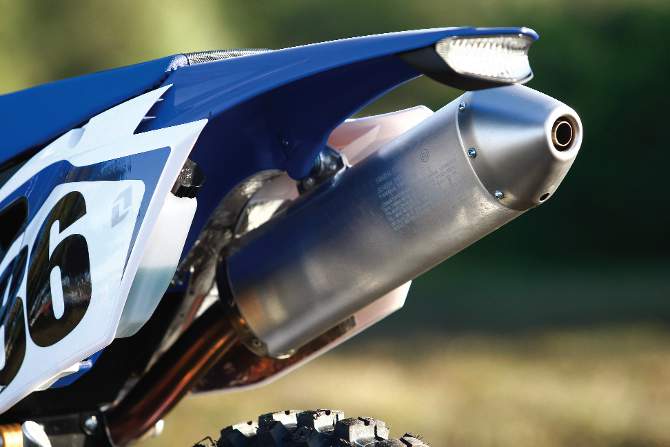
Due to EPA regulations, the WR450F has a miniscule muffler opening, along with a spark arrestor. It's very quiet.
CHAPTER TWO: THE UNVEILING
Admittedly, I had no preconceived notions about the 2012 Yamaha WR450F. Even though I make my living testing motorcycles, I hadn't ridden any previous WR models. Oddly enough, I considered this to be a good thing. Without any experience on Yamaha's offroad race bikes, my perception of the WR450F wasn't muddied. Instead, I went into the WR450F introduction with an open mind. I thought of myself as the typical buyer?a dedicated rider who wants to experience the whole spectrum of offroad riding. With little or no experience in high-tech, hardcore, offroad racing, the 2012 Yamaha WR450F and I were both new to the sport.
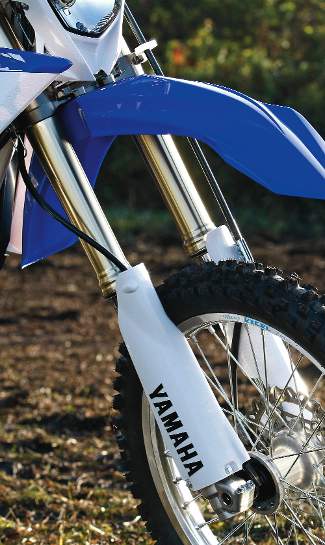
Eureka! Yamaha finally equipped the WR450F with Kayaba's renowned SSS suspension. Offroad racers will be happy.
After sitting in on the WR450F presentation, I was jacked up like a college frat rat on Red Bull during rush week. I was eager to ride Yamaha's newest bike?even if it was an "enduro bike." Why? The WR450F was similar to Yamaha's latest motocross line. I figured that I would feel right at home on the WR450F, thanks to a shared chassis with the YZ250F, electronic fuel injection from the YZ450F and Kayaba's slam-dunk Speed Sensitive System (SSS) suspension. As for the kickstand, headlight, 18-inch rear wheel and odometer, I figured I could ignore them in the punishing GNCC landscape.
Yamaha truly reinvented the WR450F. Their goal was to transform the WR from a pleasant trail bike into a race-oriented machine that could handle the demands of faster riders. How did they achieve their goals? Here's the list:
Chassis:
The biggest modification was using the current-model YZ250F frame. Preposterous, you say? Believe it or not, Yamaha's engineers managed to wedge a YZ450F engine inside the tightly configured YZ250F chassis. Of course they had to use different motor mounts, but that was the extent of the fabrication. The forged and extruded frame puts an emphasis on torsional and horizontal rigidity. Essentially, the flexing and wallowing sensations caused by the old aluminum frame were remedied by a chassis that could be ridden harder and with greater confidence. As an added bonus, the ground clearance was increased by 7mm.
Fuel injection:
Add the WR450F to the growing list of Yamaha motorcycles that come equipped with electronic fuel injection. The bike receives the same 12-port, 42mm, Keihin fuel-injection system as the YZ450F. Five separate sensors monitor the running conditions: lean angle, intake air pressure, throttle position, air temperature and water temperature. Yamaha jumped at the opportunity to equip the WR450F with EFI, as this technology provides more consistent throttle response, smoother power delivery and unwavering performance in almost all altitudes and climates.
A few notes of interest about the WR450F's switch to EFI:
(1) A capacitor can be used to eliminate the battery (and save roughly 10 pounds).
(2) The electric starter is backed up by a kick-starter.
(3) Built into the throttle body is a shutoff switch that doesn't allow a 100-percent opening of the throttle for EPA reasons. The switch can easily be removed by any backyard mechanic.
(4) As for Keihin FCR carbs, the YZ250F, TT-R play bikes, YZ125 and YZ250 two-strokes are the only carbureted bikes left at Yamaha.
Suspension:
The best news is that the WR450F joined the Kayaba SSS army. Although SSS suspension is more expensive than the Kayaba AOSS design that previous WR450Fs came with, the price is worth it. Now the damping force is controlled by the speed of the fork rather than the position of the damper rod in the fork, which makes the damping curve more linear. Understand that the WR450F and the YZ450F don't share the same spring/valving specs. The WR450F is set up much softer.
Engine:
This isn't the backwards engine from the YZ450F, but it isn't the old YZ450F engine from the pre-2010 YZ450Fs, either. It is a close relative of the old-school YZ450F mill but with modern upgrades. The mega-reliable, five-valve engine received a new crankshaft design, counterbalancer, magneto generator (with more coils and greater wattage to handle the demands of the EFI and headlight), kick-starter gears, air-cleaner boot, throttle-body joint, and a 1mm-wider big-end bearing and rod forging.
Adhering to the centralization of mass theory, Yamaha rotated the engine 5mm up in the front. This degree change put the cylinder/head at a more upright angle and raised the crank center. The goal was to give the bike a lighter feeling in the handling department. Unlike on the YZ450F, the WR450F cylinder head is facing forward. The engine is still a dry-sump design.
Radiators:
Sufficient cooling is a must in offroad racing, as the speeds are typically slower than in motocross. Yamaha beefed up the WR450F radiators, adding more fins and increasing cooling capacity by five percent.
Exhaust:
Electronic fuel injection isn't as effectively metered in the low-to-midrange as with the old Keihin FCR-equipped YZ450F, so Yamaha lengthened the head pipe by 15mm and added a resonance chamber to beef up the bottom end. The muffler has a baffle that severely restricts sound output, as well as a spark arrestor.
Body styling:
Since the WR450F uses the YZ250F frame, it's only natural that it uses YZ250F plastic. The seat and rear fender are flatter and lower by 11mm.
Gas tank:
Obviously, the gas tank had to be redesigned to accept a built-in fuel pump. This is the same pump that's on the YZ450F. There is also a sensor that activates a low-fuel warning (when there is a half-gallon left in the two-gallon tank).

Motocross nuts would go crazy riding with a steel rear sprocket and O-ring chain, but the drive train lasts forever.
CHAPTER THREE: THE RACE TEST
I rode the 2012 Yamaha WR450F on two different days under very similar course conditions. On the first day, I rode the bike stock?save for the throttle stop, which was conveniently removed. This meant that I wound through the woods with a kickstand, which is actually quite practical, and a pea-sized muffler, which, while quiet, severely limited engine performance. Regardless, the WR450F was extremely well prepared to handle a wide range of conditions.
The engine chugged over tight sand sections, pulled across short straights, muscled through deep mud holes (when I didn't crash) and had decent top speed. It was obvious that the muffler choked up the engine like an all-female audience at a showing of the The Notebook. Remember, the WR450F is made for offroad, not motocross. I was happy to sneak up on unsuspecting wild life instead of having my eardrums blown by an exhaust note more annoying than Gilbert Gottfried's voice. I could ride many sections in third gear, a tactic that prevented the suspension from loading up and bottoming out through corners. The only change I made was speeding up the idle by a few clicks to prevent engine flame-out.
Electronic fuel injection is here to stay, and the all-new Yamaha WR450F proves that point. It is must-have technology on any offroad bike. That's because offroad riders are like billy goats; they love climbing over stuff instead of going around it. Instantaneous throttle response is imperative, and it shouldn't be affected by elevation or the heat index. Just as motocross riders don't want their engines to hiccup on the face of a jump, offroaders can't accept having fuel delivery temporarily paused while wheelying a log or plowing through a deep creek crossing. The WR450F's Keihin EFI system worked flawlessly and never loaded up the engine when transitioning from a tight section to an open field?something that a poorly adjusted carburetor cannot claim.
I was tickled pink to try the Kayaba SSS suspension on the WR450F, since I consider the speed-sensitive damping to be the best showroom-stock motocross suspension on the market. Interestingly, however, the WR450F forks were too soft for my taste. The forks went through the initial part of the stroke too quickly, causing the front-end to dive and dig into the sand. I had Yamaha's testing department add 10cc of oil to the forks to stiffen them up in the second half of the stroke. Yes, the new oil height sacrificed a bit of feel in low-speed situations, but it was worth the trade-off. Maybe that's just the motocross racer in me.
I've spent a lot of time on the 2012-13 Yamaha YZ250F, so I was eager to find out how the chassis would perform with an engine that was 200cc bigger. Would the engine overpower the frame? How would the added weight of the engine change the handling traits? As it turns out, Yamaha's engineers made a brilliant decision in sandwiching the WR450F engine into the YZ250F chassis. Having ridden a few offroad bikes in the past that cornered like tankers, I can say with confidence that the WR450F is an excellent-handling machine. Given more time and familiar racetracks, I would play with the fork-leg height a bit. After adding oil to the forks, the front-end had a tendency to understeer, but in stock trim, the WR450F could hit every mark. And while blasting across sand whoops, the rear-end tracked straight and remained consistent (this statement could still be made after two hours of racing).
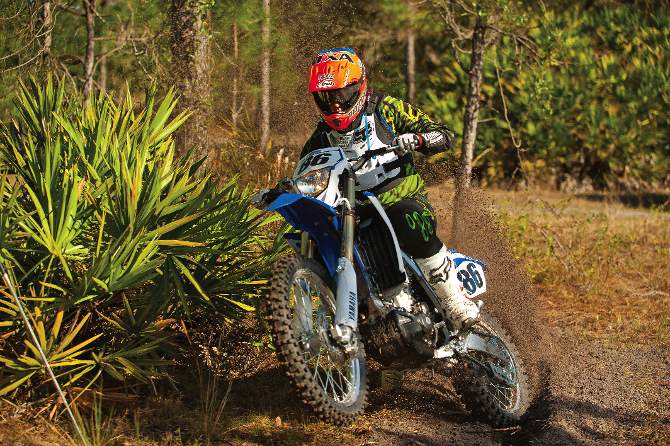
John Basher tests the bottom-end power in the Florida groves.
I initially thought I would detest a few things on the WR450F, but I grew to enjoy the bike's unfamiliar qualities. As much as I'll probably regret admitting this later?thanks to group of friends who enjoy nothing more than picking on me?I really liked the kickstand. It sounds stupid, but it was awesome being able to get done riding, or take a break in the middle of nowhere, and not have to lift the motorcycle onto a stand. I also liked the headlight, because the 35-watt unit was bright enough to illuminate hard-to-see spots on the dense palmetto-tree-lined Florida trails. The electric start was a hit. Even though it didn't fire up the engine consistently on the first press of the button, it was nice not having to kick-start the bike.
For race day, my second day on the WR450F, GYTR, Yamaha's official in-house performance division, offered a bevy of plug-and-play parts…and I availed myself of the best of them.
Naturally, my mind began to wander in the middle of the two-hour GNCC race. After all, it doesn't take long for one sand whoop or tree to look like the next. I started to think about what it would be like to make a motocross-specific WR450F. First and foremost, it would take a lot of time and money, but I figured it could be done?and MXA obviously doesn't have any budget constraints where motorcycles are concerned. How amazing it could be! A bike with excellent suspension; a broad, easy-to-ride powerband; a quick-handling chassis; durability that is second to none; and the possibility of an electric starter. Eureka! It was only then that I snapped back to reality and realized that I was about to slam my shoulder into a tree. Ouch!
Back at the Yamaha pits after the race, I was satisfied with my feeble performance and pleased to notch such a challenging experience in my gun belt. Covered in a thick layer of sand and bruised from hitting a tree, I called Jody back home in SoCal to let him know how I did, what the WR450F was like and that I thought we should build a project bike from one. His response? "How are your hands? I bet they look like you shoved them into an acid bath!" I couldn't really be offended, because I have a reputation for having the softest hands short of a line worker in the Estee Lauder factory. I get blisters in a 20-minute moto, so it was obvious that two hours of racing should have chewed my palms to pieces.
"My hands look brand new, thank you very much!" Later, I realized that perhaps the soft suspension wasn't as bad as I thought?at least when it comes to my hands. As for building a project WR450F, stay tuned, because this story is just beginning.
TALKING TO YAMAHA WR450F DESIGNER HIROSHI ITOU
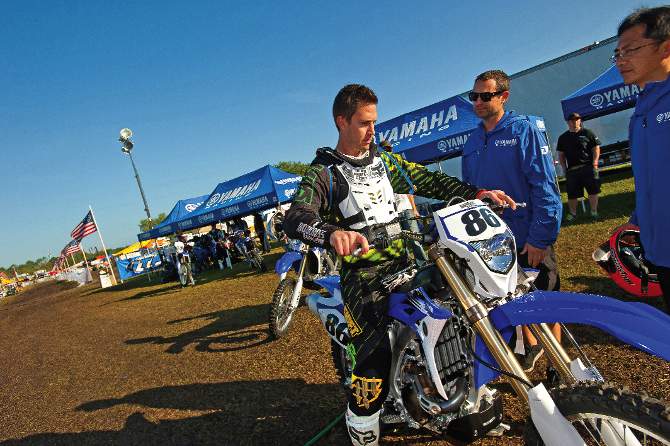
John Basher, Tim Olson and Hiroshi Itou talk setup.
What were your objectives when developing the 2012 Yamaha WR450F?
"Some riders complained about how the old WR450F was too big and heavy, although the performance was good. So, we wanted to make a smaller and lighter bike. Unfortunately, with fuel injection, we weren't quite able to drop the weight of the bike. The new model weighs just about the same as the old one. But, we can make a very compact dimension because of EFI. For example, the head pipe is 10mm back from where it was previously. We also changed the engine location; that way we could change the bike's center of gravity."
How are you able to find the balance with the front-end, since the WR450F now has a tighter steering chassis but with a lot more weight in the front than on the YZ250F?
"The most effective area for that was found in the suspension settings. Now we use the Kayaba SSS suspension. It has very good performance. The geometry is the same between the WR450F and the YZ250F. The engine brackets are the only difference between the WR450F frame and the YZ250F frame. The 450 engine is bigger. It's a very tight fit in the YZ250F frame."
Why did you choose to move from the Keihin FCR carburetor to EFI?
"Fuel injection adjusts for every type of situation. The bike can be ridden at high altitude or in very warm climates without any problems. With a carburetor, it is very difficult to set the jetting for someone riding at low altitude in a hot climate who then rides up to high altitude in a cool climate. Fuel injection is self-adjusting, and that's a good thing for many situations. The consumer also wanted EFI. It seemed like there were a million requests from the customer to change the bike from a carburetor to fuel injection."
Did you meet all of your goals in developing the 2012 Yamaha WR450F?
"I believe that we passed all of our targets. The bike is easy to ride, with good low-to-midrange power, and it works well on tight trails. I've noticed that when some bikes use fuel injection, the engine loses low-to-midrange manageability. However, we changed the exhaust pipe to help the WR450F in that area."
What were the complaints with past WR450F models?
"Our old bike was really easy to ride. It had comfortable suspension, but once you started pushing into a race pace, the chassis felt a little loose because of the suspension quality. The focus was on making a bike that you could really push to your limit in terms of suspension quality and with a more rigid chassis. It has transformed from a trail bike into a race bike without giving up the comfortable feel of a trail bike."
Did the economy have any influence over a release date for the new WR450F?
"The offroad market in the U.S. is okay right now, but in other parts of the world, such as Europe and Australia, the market is quite stable. I believe that people are waiting to get their hands on a bike like the WR450F. Now is a good time for selling this machine. We hope that this machine helps bring more customers to buy other bikes in our line. The WR450F is a good thing for the offroad market."
How many years did it take to develop the 2012 WR450F?
"It took since 2009. At that time, after finishing the YZ250F development, one of our designers thought that it might be interesting to put a WR450F engine inside a YZ250F chassis. He quickly made the prototype. We rode it. The bike was very interesting, so we decided to go in that direction."
What was the most difficult challenge you faced in developing the bike?
"We really had to make sure that we got the performance of the engine right. We started with fuel injection, but then the engine performance wasn't right. The throttle response was good, but we couldn't get the kind of low-to-midrange power we wanted. We used a longer exhaust pipe, but we were very limited by regulations. We added a resonance chamber, and that helped. It was also difficult to develop the bike for other countries."
The YZ250F is now the only carbureted Yamaha four-stroke race bike. Will the 2013 YZ250F be fuel injected?
[Laughter] "Nice try! I know, but I cannot say at this time."
What would it take to transform the WR450F into a motocross bike?
"The silencer would have to be modified. It would also be good to remove the electric starter, because it would reduce the weight by about 10 pounds. You can also change the transmission to a YZ gearbox. You can also change the cylinder head and some engine parts. The fork settings should also be changed, and the headlight should be taken off. One Japanese test rider modified the bike for motocross, and it worked very well.
MXA'S TEASER BIKE: OUR WR450F MOTOCROSS BIKE (STILL UNDER DEVELOPMENT FOR A FUTURE ISSUE)
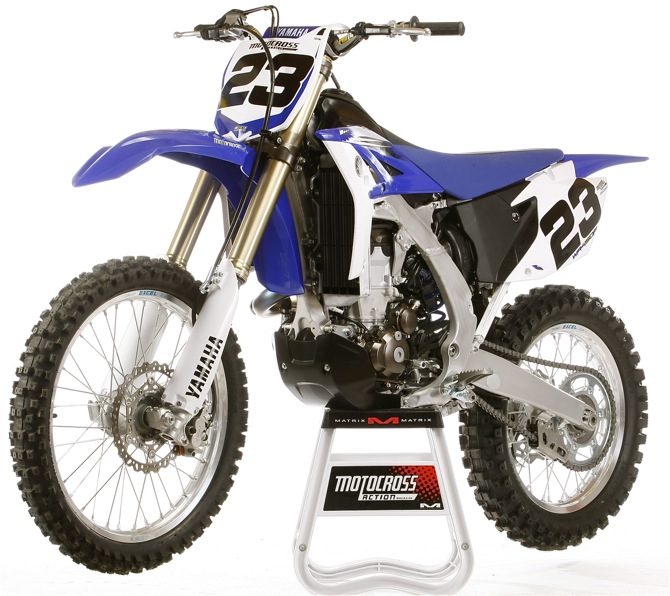
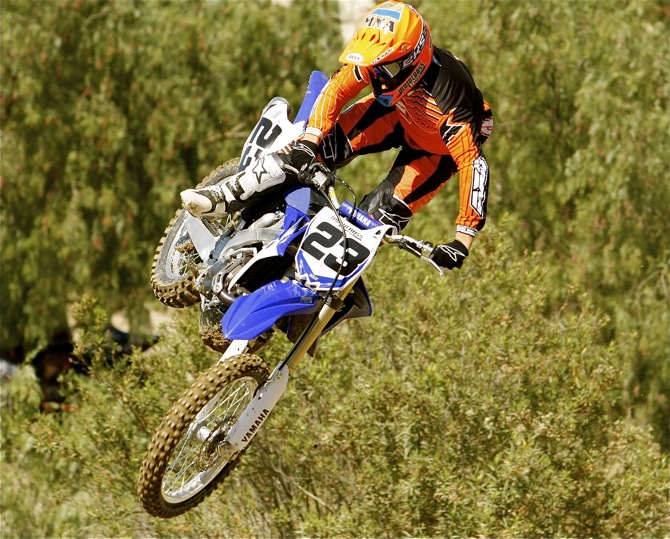

Source: https://motocrossactionmag.com/we-ride-the-all-new-yamaha-wr450f-a-yz250f-with-a-yz450f-engine/
 Reviewed by Marybon
on
Desember 05, 2021
Rating:
Reviewed by Marybon
on
Desember 05, 2021
Rating:



Tidak ada komentar: